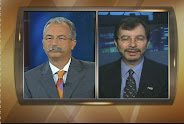Rising Long-term Interest Rates + China + Protectionism = Stock Market Correction
 In the coming weeks the din from earnings season should provide the perfect cover for what may turn out to be the single most important risk to equities: rising interest rates.
In the coming weeks the din from earnings season should provide the perfect cover for what may turn out to be the single most important risk to equities: rising interest rates.
Good results (at or above consensus) are virtually baked into the earnings season cake. Yet, it is the risk from a rising long-term interest rate environment that is poised to function as the technical analysis catalyst for a meaningful stock market correction.
Should long-term rates rise (as in above 4% in the 10 year US Treasury), there will be two factors at work that could turn rising long-term rates into the catalyst for the long overdue (and healthy) stock market correction:
1 – The direct hit to valuation models via an increase in the discount rate
2 – The technical analysis hoopla around the completion of a multi year head and shoulders bottom in the 10 year US Treasury rate (see chart)
Should long-term rates rise, the usual suspects would be the threat of inflation and the mountain debt to be issued for the foreseeable future. What many investors may miss, however, is the geopolitical collision between “American pragmatism”*, an emboldened Democratic Party and assertive President Obama, and China that results in a diminished purchase of long-term US debt and a concurrent rise in the rate. Here’s how this may turn out:
In just 217 days, voters in the US will head to the polls for the all-important mid term elections. Fresh off their healthcare bill victory, President Obama and the Democrats are feeling their oats, exemplified by Obama’s “Go for it” taunt to Republicans and his recess appointments just announced. Bye bye bi-partisanship, hello hardball politics.
To help stoke the newfound Democratic machismo will be the jobs picture. It is not advisable for investors to let this Friday’s good jobs number (if they occur) distract from the reality that global macro forces (be it globalization and the labor arbitrage or protectionism and diminished global economic growth) are likely to produce a sub par jobs growth environment in the US once again. Such an outcome in a highly political year will almost certainly produce assertive actions by the US focused squarely at the number one villain in this evolving protectionist drama – China.
So, what are the Chinese leaders likely to do if US rhetoric elevates to the point of action similar to what was noted in a recent Economist magazine commentary (“Tricky Dick and the Dollar”)? Take like the Germans did back then? I doubt it.
As Dr. Ian Bremmer (Eurasia Group) so astutely noted in yesterday’s FT article commentary (“China knows the time for lying low has ended”), the moment for just a touch of Chinese muscle flexing appears to be at hand. Moreover, the seemingly disconnected actions re Google and Rio Tinto are more likely part of the overall move (“state capitalism”**) toward a more assertive seat at the global table than a few isolated instances of Chinese governmental activism.
Yet, all pale in comparison to the one instrument of real leverage that China has that, with prudence, can be exercised against the US – its capital. China buys less US debt, diversifies away into other assets, and chooses to assist its own domestic growth needs.
On this last point, with its stimulus money all but fully spent and the need to maintain a high single digit growth rate (to avoid social unrest), China’s leaders can accomplish two goals with one act: aid and abet its domestic growth needs and demonstrate to the US that it can, and will, exercise some of its economic muscle via a diminished US debt purchasing. Weaker demand + greater supply is usually the prescription for lower prices and higher rates.
Investment Strategy Implications
Rising long-term rates cut across all markets and economic sectors. In the coming weeks, should stocks fail to capitalize on a near certain good earnings season the technical analysis stage will be set for the catalyst to produce a meaningful correction in equities. Rising long-term rates will more than fit that bill.
*Listen to my recent podcast interview with Dr. George Friedman on this topic.
**Dr. Bremmer’s soon to be published book, “The End of the Free Market”




















No comments:
Post a Comment